Seeteufel (1944)
WW2 U-Boats:
Seeteufel (1944) | Type Ia U-Boats (1936) | Type II U-Boats (1935) | Type IX U-Boats (1936) | Type VII (generic) | VIIA | VIIB | VIIC | VIIC/41 | VIIC/42 | VIID | VIIF | Type XB U-Boats (1941) | Type XIV U-Boats (1941) | Type XVII U-Boats (1944) | Type XXI U-Boats (1944) | Type XXIII U-Boats (1944) | German mini-subs and human torpedoesGenesis of a tracked submarine
The Seeteufel “Monkfish” was an evolution of the concept of human torpedoes and midget submarines that could be thrown out on the coastal areas when U-boats failed to achieve their objectives and survive to the allied total mastery of the skies and sea at that point. Launch and recovery of these was a particular problem. Ferrying midget submarines on standard railway carriages subjected to air attacks was bad enough, and finding a launching sport was also not easy.
And after completion of their short mission, it was extermely hard to have them secured for recovery on the coast. Some developed the idea that adding a way for a midget submarine to move itself could work. And to bear the load, rather than wheels, tracks seemed the obvious choice. This addition would grant the ability to go from land to water and the other way around. Tracks could be propelled by the same engines that drove the propeller.
Tracks would allow these submarines to effectively operate from any spot, and not be tied to railways or docks, allied targets of choice. To be precise on the topic these were tracked submarines, and not “submersible tanks”. They had no armour, nor any gun armament, their sole purpose was to attack allied shipping. There was no previous attempt of the genre, but WW1 saw tracked MTBs like the Grillo, or the Versuchsgleitboot, unorthodox solutions aimed at crossing the defensive nets protecting harbours, like Pola and Cattaro.
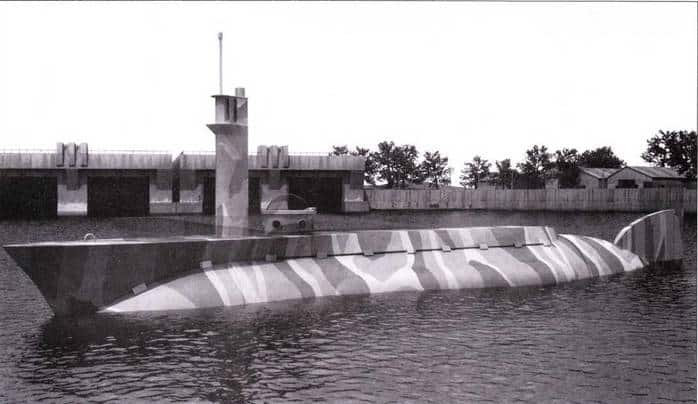
A camouflaged Seeteufel, operational in 1944. Ntice there is a detail on the photo looking like a transparent structure over the deck, encompassing the periscopic/snorkel mast, which led to misinterpretations in later drawings
The first Seeteufel (1856)
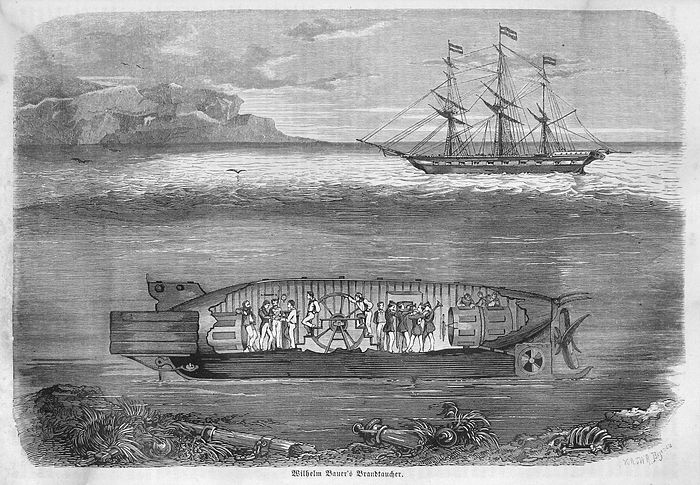
The Seeteufel was not the first of the name. Indeed the first one was designed by genius Bavarian inventor Wilhelm Bauer (see the german subs lineage).
After the failure of the Brandtaucher (1851) which almost killed him, he completely revised the design and went with the “Seeteufel” in 1856, first of the name. He had trouble finding a client for it, but eventually secured a contract with the Russians later. This Seeteufel as 52 feet long, with a crew of 12 trained to use diving suits as the boat had a diving chamber to enter or exit the submerged boat, which save the crew after an operator error.
It worked perfectly and made 133 dives around Saint Petersburg before being lost, salvaged later and retired. For such an early stage, this was a resounding success, and the name was reactivated for the 1944 experiment. This one is also quite amazing and will motive a dedicated post in the future.
Development of the Seeteufel
The second new Seeteufel was a completely new animal, born after submarine warfare did not need any more proofing, and in Germany at the end of the war, through K-Verband and Walter’s experiments, submarine warfare was going to enter a brand new leap forward in development. A tracked submarine was very much in the ideas of the time, avoiding many issues of operating midget submarines in a largely allied-dominated environment.
The prototype also known as “Elefant”, or “Loedige Projekt” was developed in just four months at the Kiel-Eckernförde torpedo testing center. The team was directed by Alois Loedige and saw the participation of Borgward at a later stage, planned to produce the Seeteufel in serie, and which effectively built armoured vehicles and unmanned wire-guided demolition tanks like the Goliath.
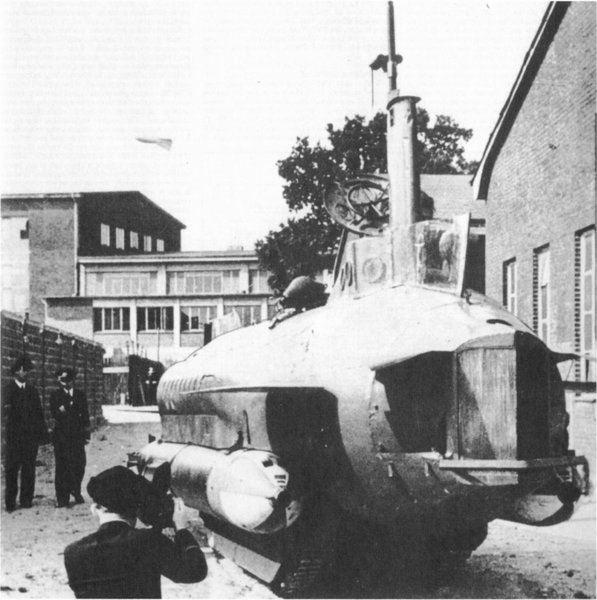
Seeteufel – a front view, early photo of the prototype examined by Kriegsmarine officers. Notice there is an unidetnified structure at the front, and still no deck, added later for seaworthiness
Design
The Seeteufel was a two-man crew submarine, reminiscent of British X-Crafts midget subs in design, averaging 20 tons when diving, tanks full.
A simple double-hull profile tube with a small deck above and cutter bow fitted above the tube. This is perhaps what led to some errors in dimensions, 13.5 being the “between parrallels” waterline figure and 14.2m the overall figure, from the bow to the tail. It was given an interesting double propulsion system, with a classic diesel electric system but also a schornchel.
The 80 hp gasoline engine provided a 10 knots speed on water but an asthmatic 10 km/h on land. The 25 hp electric motor when submerged gave the Seeteufel a cruising speed of 8 knots. The Seeteufel carried standard G7e torpedoes, or four naval mines. The G7e naval torpedo was developed to replaced the earlier G7a, standard Kriegsmarine model, 53.3 cm (21 inches) in diameter, 7.16 m in length, carrying a Schießwolle-36 mixed explosive warhead, 280 kg heavy. It was powered by 100 hp (75 kW) electric motors fed by massive lead-acid batteries, sensitive to handling and which needed pre-heating.
This was however a real progress compared to the previous G7a steam-driven model as the T2 left no visible stream of bubbles. The T3 and T4 were further improved and by 1944 the final model was likely to be the T4 or even the brand new G7es/T5 “Zaunkönig” the world’s first acoustic-driven torpedo if produced.
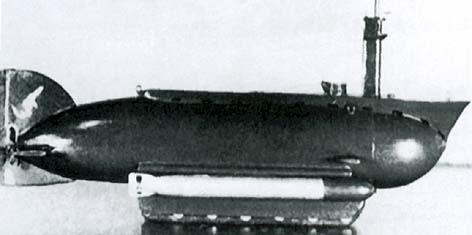
Photo of the early Seeteufel model
The Seeteufel had a displacement of circa 18.0 – 20.0 t when submerged, was 13.5 m (44.55 ft) -or 14.2 m according to other sources- by circa 2.0 m (6.6 ft) in beam, 2.9 m (9.57 ft) in depth,
and 5.5 m (18.15 ft) in height with the Schnorkel mast deployed. It was capable of a top speed of 10 knots submerged (18 kph) thanks to a (Borgward?) petrol/gas engine coupled with a Snorkel, or 8 knots on Electric power AEG E-Motor alone.
Its radius of action when surfaced was 30 hours at top speed, and 80 hours in cruising speed, which allowed to reach any destination on the coastal area. Its max diving or crushing depth (as designed) was 50 m (165 ft) while the prototype was tested to 20 m or 66 ft (25 m from another source). It could look feeble in comparison to the average u-Boats (up to 250-270 m), but as a reminder, this was a coastal submarine. Neither its diving time, stationary, or alarm moving, or the gasoline figures it carried are known. The Seeteufel was too small to carry torpedo tubes but had external drop-collars for two standard 553mm G7e (T2) torpedoes or four mines. It has no gun, only onboard Kriegsmarine crew own pistols.
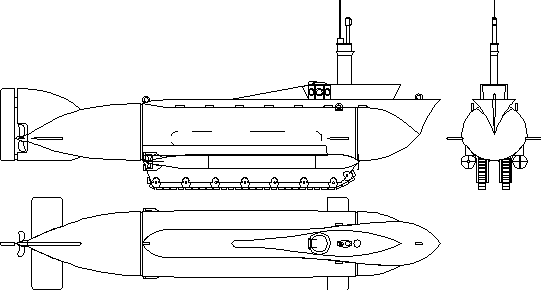
3-views of the Seeteufel
Service life
Seeteufel’s trials were preformed at Kiel-Eckernforde, and showed very good agility and handling when submerged. Land operations however proved it woefully underpowered. It could onlty reach 10 kph on flat, and was barely able to climb obstacles or slopes, which proved really a problem when trying to land ashore. As stated by the report, it was decided to fir the production model with a proper 250 hp diesel engine, which would have also probably greatly improved the surface speed. Land tests showed also its under-keel tracks system were way too narrow, making the submarine unstable and potentially prone to toppling over, while the narrow tracks were a liability on soft grounds.
The new production design would have include larger tracks with a wider separation to spread the load and decrease ground pressure. After testing was completed, K-Verband submitted the report to the Kriegsmarine, which approved a standardized preserie ordered at the Borgward factory at Bremen. But as 1944 went to its fall, the definitive order never came. It was planned on land to use flamethrowers and machine guns for aphibious operations but it never materialized and was anyway no longer a priority back then. The only prototype made was taken to a facility near Lübeck, and destroyed by explosives in April or May 1945 to prevent its capture.
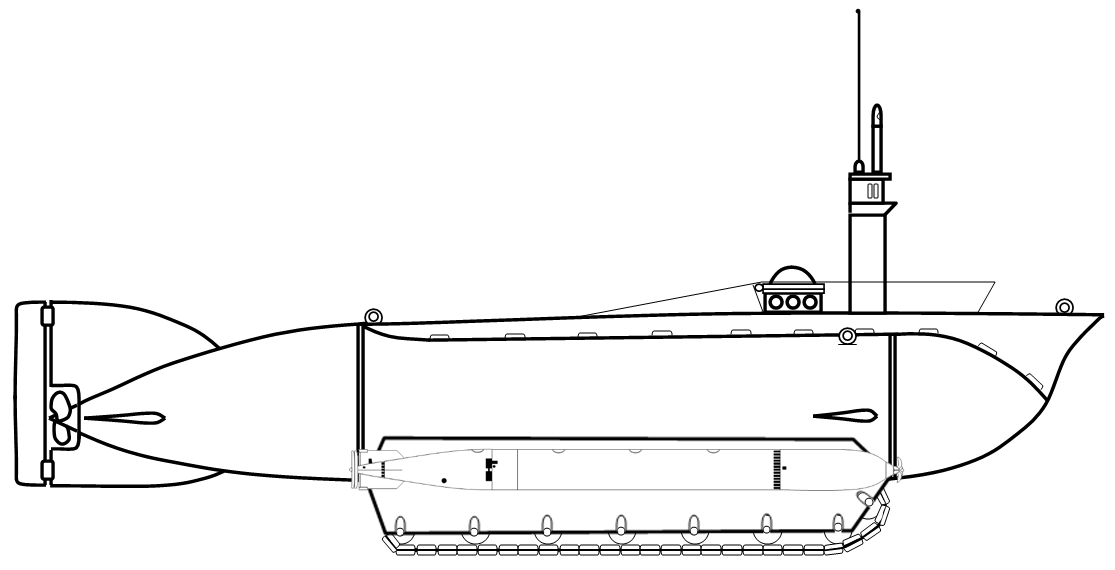
Large-scale blueprint reconstruction of the Seeteufel (wikimedia commons)
Seeteufel specifications |
|
| Dimensions | 13.5 x2.9 x5.5 m |
| Displacement | 18t/20t FL |
| Crew | 2 |
| Propulsion | 1 propeller, 1 gas. engine 80 hp, electric motor |
| Speed | 28 knots (42 km/h; 20 mph) |
| Armament | 2x 533 mm G7e T4 torpedoes/4 mines |
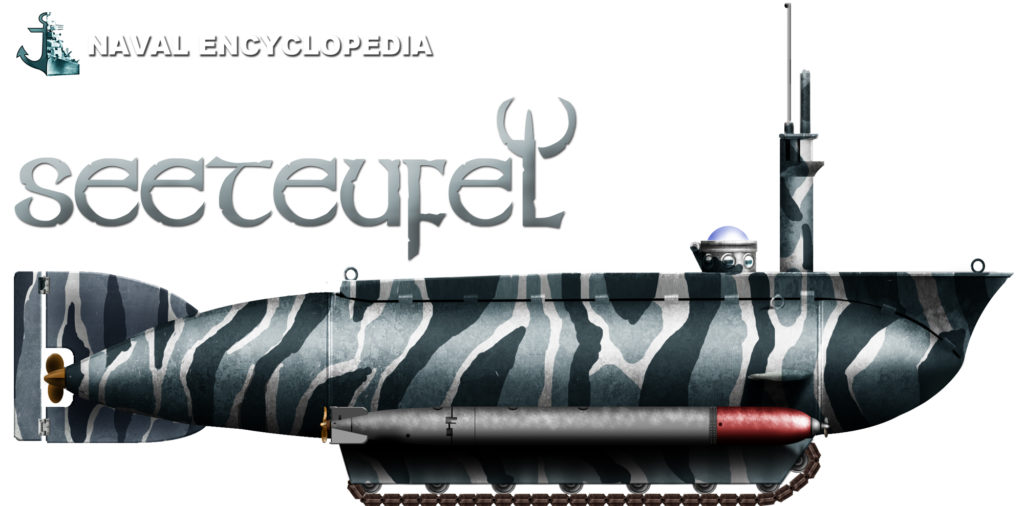
More accurate rendition of the camouflage by the Author
Read More/Sources
http://strangevehicles.greyfalcon.us/BORGWARD%20SEETEUFEL.htm
http://www.submarine-history.com/NOVAtwo.htm
https://wikivisually.com/lang-de/wiki/Seeteufel_(U-Boot)
https://en.wikipedia.org/wiki/G7e_torpedo
http://deacademic.com/dic.nsf/dewiki/1269444
https://en.valka.cz/topic/view/20575/Seeteufel
http://my.fit.edu/~swood/History_pg2.html
https://civilianmilitaryintelligencegroup.com/16088/the-seeteufel-or-sea-devil-germanys-midget-two-man-amphibious-submarine
https://uboat.net/media/boats/types/stfl3.gif
https://en.wikipedia.org/wiki/Seeteufel
https://uboat.net/types/steufel.htm
http://web.archive.org/web/20110927182658/http://www.dataphone.se/~ms/ubootw/boats_type-seeteufel.htm
Conway’s all the world’s fighting ships 1922-1946
Eberhard Rössler: Geschichte des deutschen U-Bootbaues. 2. Auflage. Bernard & Graefe Verlag, Bonn 1996, ISBN 3-86047-153-8.
Richard Lakowski: Deutsche U-Boote geheim 1935–1942. Mit 200 bisher unveröffentlichten Dokumenten aus den Akten des Amtes Kriegsschiffbau 3. Auflage. Brandenburgisches Verlagshaus, Berlin 1997, ISBN 3-89488-030-9.
Hans H. Hildebrand, Albert Röhr, Hans-Otto Steinmetz: Die deutschen Kriegsschiffe. Biographien, ein Spiegel der Marinegeschichte von 1815 bis zur Gegenwart. Mundus Verlag, Ratingen 1995, ISBN 3-88385-028-4.


 Latest Facebook Entry -
Latest Facebook Entry -  X(Tweeter) Naval Encyclopedia's deck archive
X(Tweeter) Naval Encyclopedia's deck archive Instagram (@navalencyc)
Instagram (@navalencyc)





 French Navy
French Navy Royal Navy
Royal Navy Russian Navy
Russian Navy Armada Espanola
Armada Espanola Austrian Navy
Austrian Navy K.u.K. Kriegsmarine
K.u.K. Kriegsmarine Dansk Marine
Dansk Marine Nautiko Hellenon
Nautiko Hellenon Koninklije Marine 1870
Koninklije Marine 1870 Marinha do Brasil
Marinha do Brasil Osmanlı Donanması
Osmanlı Donanması Marina Do Peru
Marina Do Peru Marinha do Portugal
Marinha do Portugal Regia Marina 1870
Regia Marina 1870 Nihhon Kaigun 1870
Nihhon Kaigun 1870 Preußische Marine 1870
Preußische Marine 1870 Russkiy Flot 1870
Russkiy Flot 1870 Svenska marinen
Svenska marinen Søværnet
Søværnet Union Navy
Union Navy Confederate Navy
Confederate Navy Armada de Argentina
Armada de Argentina Imperial Chinese Navy
Imperial Chinese Navy Marinha do Portugal
Marinha do Portugal Mexico
Mexico Kaiserliche Marine
Kaiserliche Marine 1898 US Navy
1898 US Navy Sovietskiy Flot
Sovietskiy Flot Royal Canadian Navy
Royal Canadian Navy Royal Australian Navy
Royal Australian Navy RNZN Fleet
RNZN Fleet Chinese Navy 1937
Chinese Navy 1937 Kriegsmarine
Kriegsmarine Chilean Navy
Chilean Navy Danish Navy
Danish Navy Finnish Navy
Finnish Navy Hellenic Navy
Hellenic Navy Polish Navy
Polish Navy Romanian Navy
Romanian Navy Turkish Navy
Turkish Navy Royal Yugoslav Navy
Royal Yugoslav Navy Royal Thai Navy
Royal Thai Navy Minor Navies
Minor Navies Albania
Albania Austria
Austria Belgium
Belgium Columbia
Columbia Costa Rica
Costa Rica Cuba
Cuba Czechoslovakia
Czechoslovakia Dominican Republic
Dominican Republic Haiti
Haiti Hungary
Hungary Honduras
Honduras Estonia
Estonia Iceland
Iceland Eire
Eire Equador
Equador Iran
Iran Iraq
Iraq Latvia
Latvia Liberia
Liberia Lithuania
Lithuania Mandchukuo
Mandchukuo Morocco
Morocco Nicaragua
Nicaragua Persia
Persia San Salvador
San Salvador Sarawak
Sarawak Uruguay
Uruguay Venezuela
Venezuela Zanzibar
Zanzibar Warsaw Pact Navies
Warsaw Pact Navies Bulgaria
Bulgaria Hungary
Hungary

 Bundesmarine
Bundesmarine Dutch Navy
Dutch Navy Hellenic Navy
Hellenic Navy Marina Militare
Marina Militare Yugoslav Navy
Yugoslav Navy Chinese Navy
Chinese Navy Indian Navy
Indian Navy Indonesian Navy
Indonesian Navy JMSDF
JMSDF North Korean Navy
North Korean Navy Pakistani Navy
Pakistani Navy Philippines Navy
Philippines Navy ROKN
ROKN Rep. of Singapore Navy
Rep. of Singapore Navy Taiwanese Navy
Taiwanese Navy IDF Navy
IDF Navy Saudi Navy
Saudi Navy Royal New Zealand Navy
Royal New Zealand Navy Egyptian Navy
Egyptian Navy South African Navy
South African Navy






























 Ukrainian Navy
Ukrainian Navy dbodesign
dbodesign